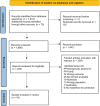Predicting postpartum haemorrhage: A systematic review of prognostic models
- PMID: 35918188
- PMCID: PMC10087871
- DOI: 10.1111/ajo.13599
Predicting postpartum haemorrhage: A systematic review of prognostic models
Abstract
Background: Postpartum haemorrhage (PPH) remains a leading cause of maternal mortality and morbidity worldwide, and the rate is increasing. Using a reliable predictive model could identify those at risk, support management and treatment, and improve maternal outcomes.
Aims: To systematically identify and appraise existing prognostic models for PPH and ascertain suitability for clinical use.
Materials and methods: MEDLINE, CINAHL, Embase, and the Cochrane Library were searched using combinations of terms and synonyms, including 'postpartum haemorrhage', 'prognostic model', and 'risk factors'. Observational or experimental studies describing a prognostic model for risk of PPH, published in English, were included. The Critical Appraisal and Data Extraction for Systematic Reviews of Prediction Modelling Studies checklist informed data extraction and the Prediction Model Risk of Bias Assessment Tool guided analysis.
Results: Sixteen studies met the inclusion criteria after screening 1612 records. All studies were hospital settings from eight different countries. Models were developed for women who experienced vaginal birth (n = 7), caesarean birth (n = 2), any type of birth (n = 2), hypertensive disorders (n = 1) and those with placental abnormalities (n = 4). All studies were at high risk of bias due to use of inappropriate analysis methods or omission of important statistical considerations or suboptimal validation.
Conclusions: No existing prognostic models for PPH are ready for clinical application. Future research is needed to externally validate existing models and potentially develop a new model that is reliable and applicable to clinical practice.
Keywords: maternal mortality; postpartum haemorrhage; pregnancy; prognosis; risk factors.
© 2022 The Authors. Australian and New Zealand Journal of Obstetrics and Gynaecology published by John Wiley & Sons Australia, Ltd on behalf of Royal Australian and New Zealand College of Obstetricians and Gynaecologists.
Figures
Similar articles
-
Predicting risk of postpartum haemorrhage: a systematic review.BJOG. 2021 Jan;128(1):46-53. doi: 10.1111/1471-0528.16379. Epub 2020 Aug 5. BJOG. 2021. PMID: 32575159
-
Aetiology and treatment of severe postpartum haemorrhage.Dan Med J. 2018 Mar;65(3):B5444. Dan Med J. 2018. PMID: 29510809 Review.
-
Risk factors for severe postpartum haemorrhage during caesarean section for placenta praevia.J Obstet Gynaecol. 2020 May;40(4):479-484. doi: 10.1080/01443615.2019.1631769. Epub 2019 Sep 3. J Obstet Gynaecol. 2020. PMID: 31476931
-
Trends and outcomes of postpartum haemorrhage, 2003-2011.BMC Pregnancy Childbirth. 2015 Dec 15;15:334. doi: 10.1186/s12884-015-0788-5. BMC Pregnancy Childbirth. 2015. PMID: 26670767 Free PMC article.
-
Maternal outcomes following massive obstetric haemorrhage in an inner-city maternity unit.J Obstet Gynaecol. 2019 Jul;39(5):601-605. doi: 10.1080/01443615.2018.1534814. Epub 2019 Mar 1. J Obstet Gynaecol. 2019. PMID: 30821181
Cited by
-
Evaluation of the Association Between Postpartum Hemorrhage and Antidepressant Use: A Mendelian Randomization Study.Drugs Real World Outcomes. 2025 Jun;12(2):325-333. doi: 10.1007/s40801-025-00490-1. Epub 2025 Apr 16. Drugs Real World Outcomes. 2025. PMID: 40238033 Free PMC article.
-
Challenges and Opportunities for Data Science in Women's Health.Annu Rev Biomed Data Sci. 2023 Aug 10;6:23-45. doi: 10.1146/annurev-biodatasci-020722-105958. Epub 2023 Apr 11. Annu Rev Biomed Data Sci. 2023. PMID: 37040736 Free PMC article. Review.
-
Quantifying the Accuracy of Clinician Risk Assessment for Postpartum Hemorrhage.Matern Fetal Med. 2024 Oct 11;6(4):211-214. doi: 10.1097/FM9.0000000000000242. eCollection 2024 Oct. Matern Fetal Med. 2024. PMID: 40406176 Free PMC article.
-
Accuracy of machine learning and traditional statistical models in the prediction of postpartum haemorrhage: a systematic review.BMJ Open. 2025 Mar 3;15(3):e094455. doi: 10.1136/bmjopen-2024-094455. BMJ Open. 2025. PMID: 40032385 Free PMC article.
-
Development of antepartum risk prediction model for postpartum hemorrhage in Lagos, Nigeria: A prospective cohort study (Predict-PPH study).Int J Gynaecol Obstet. 2024 Jul;166(1):343-352. doi: 10.1002/ijgo.15364. Epub 2024 Jan 17. Int J Gynaecol Obstet. 2024. PMID: 38234155 Free PMC article.
References
-
- Say L, Chou D, Gemmill A et al. Global causes of maternal death: A WHO systematic analysis. Lancet Glob Health 2014; 2(6): 323–333. - PubMed
-
- Al‐Zirqi I, Vangen S, Forsen L, Stray‐Pedersen B. Prevalence and risk factors of severe obstetric haemorrhage. BJOG An Int J Obstet Gynaecol 2008; 115(10): 1265–1272. - PubMed
-
- Cameron C, Roberts CL, Olive EC et al. Trends in postpartum haemorrhage. Aust N Z J Public Health 2006; 30(2): 151–156. - PubMed
Publication types
MeSH terms
LinkOut - more resources
Full Text Sources
Miscellaneous


